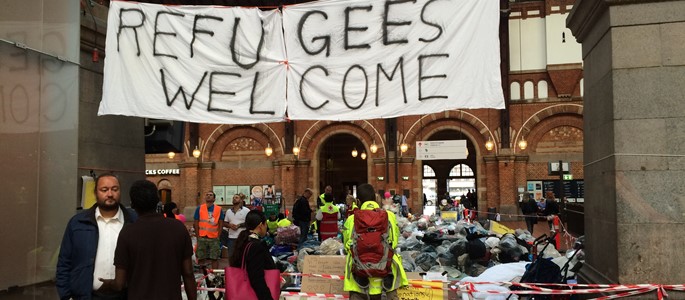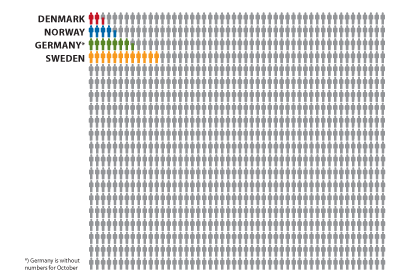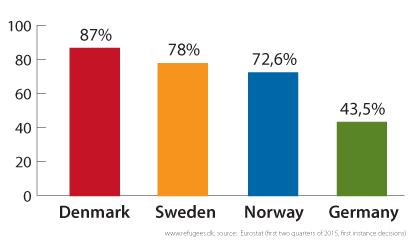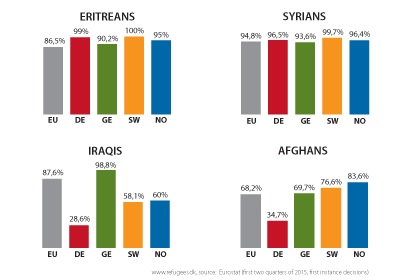Comparison between Denmark and our neighbouring countries
Is it a rational choice when so many head for Sweden and Germany instead of Denmark?
UPDATE December: all the countries mentioned, Denmark first, have introduced hard tightenings after the article was published. Waiting time in Denmark for first asylum interview has gone up to one year, and tent camps have been set up for some of the single men. The comparison is therefore no longer quite true.
Germany, Sweden and Norway have all received comparatively many more refugees than Denmark. But what are the differences in fact between the four countries, when it comes to receiving and processing asylum seekers, as well as their future options?
Asylum seekers per 1,000 inhabitants, Jan-Oct 2015
Refugees react on rumours and personal contacts, and not so much on actual facts. From outside it is difficult to make a useful comparison between the European countries. Traditionally, asylum seekers in Europe have tended to go to countries where they have family members or speak the language – there is often a certain pattern of former colony states. But large groups can suddenly change direction based on a rumour coming from their countrymen.
During this summer we have seen thousands travelling around or through Denmark, in spite of the fact that in some ways conditions are better here than in our neighbour countries. According to the refugees themselves, this is due to our government's clear messages that they are not welcome here, and the rumour that everybody will only get 1 year residence permit without right to family reunification (the new §7,3 status).
It is a fact, however, that only around 10% are targeted by the new 1 year status, that Denmark has the highest recognition rate in Europe and the fastest processing time, and that accommodation is much better than in our overloaded neighbour countries.
Sweden has just announced that newcoming asylum seekers will not be offered accommodation, and if they came through Denmark they should return to here. The Danish police changed their practice in September, no longer taking fingerprints against people's will. If the normal procedure had been continued, many thousands could have been returned from Sweden to Denmark according to the Dublin regulation.
Recognition rates 2015, 4 countries
RECOGNITION RATES 2015, 4 nationalities
Germany
CURRENTLY: So far, 577,000 have asked for asylum in Germany this year (October not counted yet), 1 mio are expected totally in 2015. 10,000 are crossing the border every day, in Sepember alone 225,000 came to the state of Bayern. Schools and sport halls are being used to accommodate people, several thousands are living in tent camps and one state has passed a bill allowing the authorities to use private buildings if they are empty.
BACKGROUND: Angela Merkel has been in the front line and encouraged EU to take responsibility for refugees, and she has made special access for Syrian refugees. The word has been spread about this and brought Germany on the top of the wish list of refugees. However, for several year Germany has had a significant amount of asylum seekers who are considered Manifestly Unfounded in Denmark as they have no chance of getting asylum: Albanians, Kosovars, Serbs and Macedonians. The political atmosphere in Germany is starting to turn against Merkel's open policy.
ADVANTAGES: Germany has the highest recognition rate for Iraqis, and also quite good for Afghans. There are many unskilled jobs in the German industry.
DISADVANTAGES: Waiting times to get asylum and especially family reunification has been very long for years, in particular piling up at the German embassies in Turkey, and with the current influx we will see waiting times of several years. Allowances and minimum wages are low, health insurance is private (most often part of a job contract). Education is not free, a semester in university will typically cost 500€, and the German study allowance is lower than the Danish. Racism and hate crimes are a serious problem in Germany with refugee homes being burnt down and refugees attacked in the streets.
Sweden
CURRENTLY: Until now 112,000 have asked for asylum in Sweden in 2015, of these are 23,000 unaccompanied minors. Around 1,000 are arriving every day. The numbers have been high for many years, and this puts pressure on accommodation – temporary as well as permanent. Some municipalities have been forced to install newcomers in sport hall, schools and libraries. The authorities are getting ready to use tents now. The large number of unaccompanied minors is a special challenge because they are the immediate responsibility of the municipalities and not the state, and they have the right to get a personal representative.
BACKGROUND: Sweden has been known through decades for a more open and humane refugee policy than the rest of Europe, for instance Sweden received more than half of all the Iraqi refugees coming to Europe during the Iraq war. Sweden insists on seeing refuges and migrants as an investment and a benefit, and the multi cultural society is considered positive. This policy has been supported by the majority for a long time, but lately the nationalist party Sverigesdemokraterne has grown significantly, showing a rising resistance against the government policy. The current influx has put the Swedish society and the economy under heavy pressure, and the reception system is about to collapse.
ADVANTAGES: Requirements for permanent residency are easy to meet, and citizenship can be acquired after only four years. Health and education is free except some fees, children have the right to mother tongue lessons. During the asylum process you can stay in private accommodation if you wish, and if you are granted residence you are free to stay where you want. Requirements to get family reunification are not strict, and the plane ticket is paid for refugees' families. Afghans and Iraqis have a higher chance of getting asylum than in Denmark, but lower than Germany.
DISADVANTAGES: The large numbers coming during recent years and especially right now means longer waiting times for processing asylum and family reunification cases, and housing has become difficult and expensive. Already in September 10,000 were waiting for temporary accommodation from Migrationsverket. Language schools, reception classes, interpreters and job centers are also under pressure. In general, Swedes are postive towards refugees, but groups of racists and neo nazis are very active, and since June 24 refugee homes have been burned down deliberately. Finding jobs for so many newcomers will probably also prove to be hard over the next years, and this will put a strain on the economy and the positive attitude.
Norway
CURRENTLY: 22,000 have already asked for asylum in Norway this year, which is an unusually high number for the country. The influx has been rising sharply in recent months. Traditionally, Sweden has always been more popular for refugees than Norway. Earlier this year, the government decided to take an extra quota of refugees from Syria, and it is also a part of the EU resettlement deal.
BACKGROUND: Norway has followed the Danish tightenings several times. Since 2013 the nationalist Fremskridtspartiet has been part of the government, and they are pushing for more restrictions.
ADVANTAGES: Very high recognition rate for Afghans. Apart from that, there are no advantages compared to Sweden, Denmark or Germany. But recently a special way of entering through Russia has been found, and this has increased the numbers.
DISADVANTAGES: Long waiting times, 10-13 months for asylum cases and 18 months for family reunification. As in Denmark it is not a free choice where to stay, during the processing time you will have to stay in remote camps, and permanent residency can only be obtained after 5 years temporary stay (as in Denmark). For family reunification there is a fee of 5,900 NKR per person, and the flight ticket will not be paid. Besides, you have to apply within the first 6 montsh after being granted residence. There is a lack of housing in Norway. Already in September 5,000 were waiting for accommodation – and since then, another 8,800 have arrived.
Denmark
CURRENTLY: Including October, 14,200 have asked for asylum in Denmark, which is on the line of last year. The huge rise in numbers in our neighbour countries has not affected us. Very surprisingly, the police has stopped taking fingerprints since September, letting people continue freely to Sweden. For this reason, the Danish asylum system is not overloaded and the processing times are short. There is room in the asylum camps and things work in a normal way.
BACKGROUND: All over the world people have heard that Denmark does not like refugees and they will only be given one year of residence without access to family reunification. A rumour which has been deliberately spread by the government and which is highly exaggerated, as it only targets around 10% of those who are granted asylum. Over many years, Denmark has been in front when it comes to tightening the asylum legislation, and we are outside the common EU policy and the new relocation deal.
ADVANTAGES: Shorter waiting times for processing asylum and family reunification cases, especially for Syrians and Eritreans. Better accommodation, very few hate crimes against refugees, local support groups for refugees all over the country. Less strain on housing, reception classes, language schools etc. Free education with high allowance (SU), free health care, high minimum wages.
DISADVANTAGES: Remarkably lower recognition rates for Afghans and Iraqis than our neighbour countries. The government is hostile towards refugees, and more tightenings are on the way. The new "integration allowance" is very hard to survive on, there are high requirements to obtain permanent residency and citizenship – for some, it will never be possible. The Danish immigration policy is built on demands and requirements, and there is an unjustly big difference in how the municipalities receive refugees.





